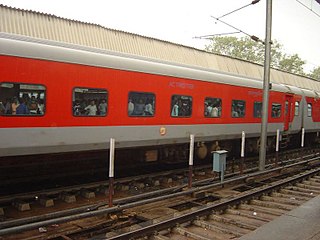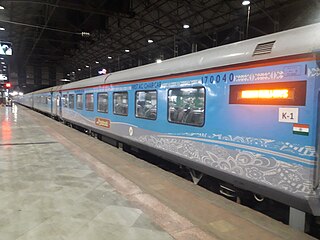
Rail transport in India consists of primarily of passenger and freight shipments along an integrated rail network. Indian Railways (IR), a statutory body under the ownership of the Ministry of Railways of the Government of India, operates India's national railway system. It is the primary owner and operator of rail operations throughout the country including suburban rail in major metros.

The Rajdhani Express is a series of passenger train services in India operated by Indian Railways connecting the national capital New Delhi with the capitals or the largest cities of various states. Rajdhani, derived from the Sanskrit means "capital". Introduced in 1969, the trains are amongst the premium services operated by Indian Railways and regularly get a higher priority on the railway network.

Shatabdi Express are a series of fast passenger trains operated by Indian Railways. Shatabdi Express are day trains and mostly return to their origin station the same day. The trains were first introduced in 1988 and were named 'Shatabdi', meaning 'century', to commemorate the birth centenary of India's first Prime Minister Jawaharlal Nehru. The trains run at a maximum permissible speed of 110–150 km/h (68–93 mph) with the Rani Kamalapati–New Delhi Shatabdi Express achieving the maximum permissible speed of 150 km/h (93 mph) between Tughlakabad and Bilochpura Agra.

The Garib Rath trains are a series of no-frills trains operated by Indian Railways to provide air-conditioned train travel at a cheaper rate compared to regular trains.

The 12001/02 Rani Kamlapati (Habibganj)-New Delhi Shatabdi Express is a train operated by the Northern Railways which runs between New Delhi, the main railway station of India's capital territory, New Delhi, and Rani Kamlapati (Habibganj) Railway Station, the suburban railway station of Bhopal, the state capital of the central Indian state of Madhya Pradesh. It is one of the fastest train in India with a maximum permissible speed of 150 km/h (93 mph).

Indian Railways operates India's railway system and comes under the purview of the Ministry of Railways of Government of India. As of 2023, it maintains over 108,706 km (67,547 mi) of tracks and operates over 13,000 trains daily. According to the Ministry of Railways, a route capable of supporting trains operating at more than 160 km/h (100 mph) is considered as a higher speed or semi-high speed rail line.

The Jan Shatabdi Express is a more affordable and economical version of the Shatabdi Express. The word 'Jan' refers to common people. Being an economical version of the Shatabdi Express, it provides the passenger with Air Conditioned Chair Car, Second Class Seating and Unreserved classes. Though its priority is less than that of the trains like Rajdhani Express, Shatabdi Express and Duronto Express, it enjoys a greater priority than the Mail, Express and the Superfast Express trains of Indian Railways. The maximum permissible speed of this train is 130 km/h.

India has a system of express trains, operated by Indian Railways which comes under the purview of the Ministry of Railways of Government of India. As of 2023, it maintains over 108,706 km (67,547 mi) of tracks and operates nearly 3,000 express trains daily. According to the Ministry of Railways, express trains travel faster and have limited stops than ordinary passenger trains. Any passenger train with an average speed higher than 55 km/h (34 mph) is considered super-fast.
This article seeks to list all the trains that ply between two cities in India. The trains listed in the set of cities must be the originating & terminating cities respectively.
AC Express trains are fully air-conditioned Superfast Express trains linking major cities in India. They have high priority at intersections and are amongst the fastest trains in India. Although the top speed of 130 km/h is reached in some sections, on most sections trains are restricted to a speed of 110 km/h. AC Express train fares do not cover food, however the bedroll is free for passengers who are traveling on this train. AC Express trains are often cheaper than those of the Rajdhani Express, Duronto Express and Humsafar Express. Some AC Express trains have pantry cars.

Double Decker Express are a series of trains started by Indian Railways for shorter routes in order to serve more people than a traditional chair car carriage.
The Indian Government is undertaking several initiatives to upgrade its aging railway infrastructure and enhance its quality of service. The Railway Ministry has announced plans to invest ₹5,400,000 crore to upgrade the railways by 2030. Upgrades include 100% electrification of railways, upgrading existing lines with more facilities and higher speeds, expansion of new lines, upgrading railway stations, introducing and eventually developing a large high-speed train network interconnecting major cities in different parts of India and development of various dedicated freight corridors to cut down cargo costs within the country.

Antyodaya Express are a series of trains operated by Indian Railways. The trains were initially proposed to be overnight unreserved trains in the 2016 Railway budget of India, but were later converted to include reserved coaches. Antyodaya refers to the uplifting of the weaker section of a society. The coaches are designed by Indian Railways with features such as bio-toilets and dedicated power sockets.

Vande Bharat Express is a medium-distance superfast express service operated by Indian Railways. It is a reserved, air-conditioned chair car service connecting cities that are less than 800 km (500 mi) apart or take less than ten hours to travel with existing services. The train entered commercial service on 15 February 2019.
The 22671/22672 Chennai Egmore–Madurai Junction Tejas Express is India's second semi-high speed Tejas Express introduced by Indian Railways connecting Chennai Egmore and Madurai Junction in Tamil Nadu, after Mumbai CSMT–Karmali Tejas Express. It is currently being operated with 22671/22672 train numbers on six days a week basis. At present, it is the only Tejas Express running in Tamil Nadu as well as in Entire South India.

The 20901/20902 Mumbai Central - Gandhinagar Capital Vande Bharat Express is India's 3rd Vande Bharat Express train, connecting the states of Maharashtra and Gujarat.

The 22549/22550 Gorakhpur - Prayagraj (Allahabad) Vande Bharat Express is India's 25th Vande Bharat Express train, connecting the city of Gorakhpur City via Ayodhya and terminating at the city of Prayagraj in Uttar Pradesh. This express train is a former of another service which terminated at state capital city Lucknow which was inaugurated by Prime Minister Narendra Modi on 7 July 2023.

The 20665/20666 Chennai Egmore - Tirunelveli Vande Bharat Express is India's 28th Vande Bharat Express train, which is running across the state of Tamil Nadu by connecting the cities of Chennai, Villupuram, Tiruchirappalli, Dindigul, Madurai, Virudhunagar and terminating at Tirunelveli. This train was inaugurated on 24 September 2023, by Prime Minister Narendra Modi via video conference from New Delhi.

The 22231/22232 Kalaburagi (Gulbarga) - SMVT Bengaluru Vande Bharat Express is India's 42nd Vande Bharat Express train, connecting the city of Kalaburagi with the 'silicon valley of India' and capital Bangalore in Karnataka. This express train was inaugurated by Prime Minister Narendra Modi via video conferencing from Ahmedabad on March 12 2024.
The 22962/22961 Ahmedabad - Mumbai Central Vande Bharat Express is India's 45th Vande Bharat Express train, connecting the largest city of Gujarat, Ahmedabad with the west coastal capital city Mumbai in Maharashtra. This express train was inaugurated by Prime Minister Narendra Modi via video conferencing from Ahmedabad on March 12 2024.

















